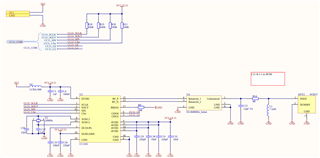Tool/software:
After the initial configuration of the CC1101 radio transceiver on the MCU side, an issue has been observed where the interrupt pin begins to generate interrupts at a very high frequency, approximately 135 kHz. This behavior occurs immediately following the CC1101 setup and seems to be triggered sporadically. The continuous stream of interrupts overwhelms the MCU's interrupt handling, effectively blocking the execution of other critical tasks. As a result, the system fails to feed the watchdog timer, leading to a forced MCU reset. However, the problem persists post-reset: upon reboot, the CC1101 continues to emit high-frequency interrupts, causing the board to enter a bootloop state. This renders the system non-functional until manual intervention or a hard reset of the CC1101 module is performed. This issue doesn't occur consistently, but it sometimes appears after power-up. What could be the root cause?
Here is the oscilloscope diagram of what is happening on this pin:





